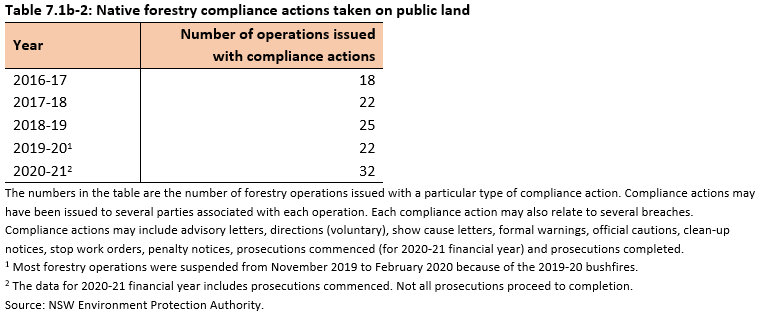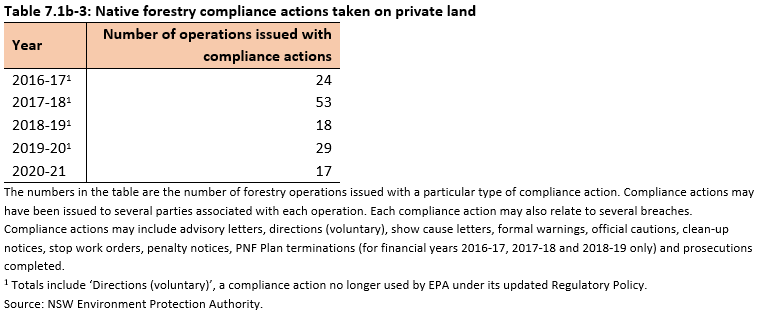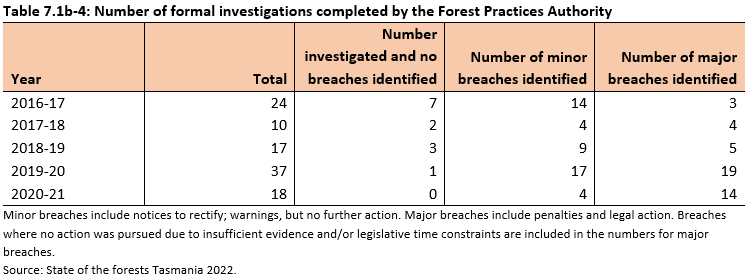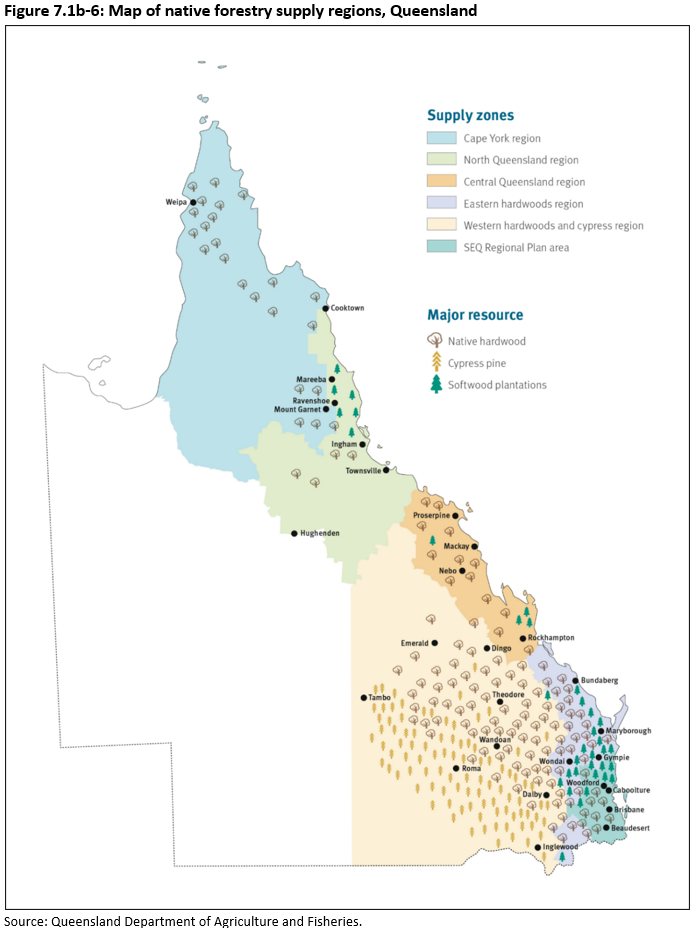This indicator examines the institutional frameworks that support sustainable forest management. Institutional frameworks provide mechanisms for engagement of the wider community in the process of continuous improvement and sustainable forest management.
This is Supporting information for Indicator 7.1b, published July 2024.
The management of Australia’s forests is guided by the National Forest Policy Statement. The statement outlines 11 broad national goals. The three goals most relevant to Indicator 7.1b are integrated and coordinated decision-making and management; employment, workforce education and training; and public awareness, education and involvement. Through this statement and other policy mechanisms, Australia’s national, state and territory governments are committed to the sustainable management of all Australia’s forests, whether the forest is on public or private land, or within a conservation reserve or a production forest.
Through the National Forest Policy Statement, the governments of Australia agreed to Forest Practices Related to Wood Production in Native Forests: National Principles (Attachment A to the National Forest Policy Statement) and Forest Practices Related to Wood Production in Plantations: National Principles. The governments agreed that the principles should be applied to the management of all public and private native forests and plantations in Australia. These principles provide for a consistent and scientific basis for sound forest management to which all states and territories are committed.
Much of Australia’s production native forests and plantation forests are owned and/or managed by large public or private organisations. The operations of these organisations are usually conducted through recognised forest management systems, using policies, guidelines, protocols and other instruments that promote the sustainable management of forests and the engagement of the wider community. Their policies are stated publicly, generally relate to sustainability, forest stewardship and environmental awareness, and guide forest management planning and operational practices.
Australia has well-established non-legislative mechanisms for public participation and for raising awareness of forest management planning, in addition to those prescribed in legislation (see Indicator 7.1a). These non-legislative mechanisms include the provision of information on forest resources, impacts, uses and values; discussion papers on alternative plans; invitations to provide comment or written submissions; and discussion forums and public meetings. For example, extensive public consultation occurred during the creation of each of the ten Regional Forest Agreements.
At the national level, the Australian Government coordinates the Australia’s State of the Forests Report and the Australia State of the Environment report, which provide status updates to the wider community based on available information. Key online sources of national forest information include the Forests Australia website, the Forest Learning website, and the Forest Education Foundation website.
All public forest management agencies publish forest-related information, such as annual reports and technical papers on research and matters of interest, and seek community engagement on issues of community concern. Some states and territories also publish their own state-of-the-forests (or equivalent) reports (see Indicator 7.1d). Many public forest management agencies also provide forest education and awareness resources, and maintain visitor information centres promoting public participation, education and awareness.
Across Australia, 21 million hectares of forest (as at 2023) is managed by Indigenous peoples and communities. A further 11 million hectares (as at 2023) is co-managed by Indigenous peoples and communities under a formal, legally binding agreement to include Indigenous input in the process of developing and implementing a management plan. The level of Indigenous community participation varies between states and territories and organisations.
The Forestry Corporation of New South Wales employs an Aboriginal Partnerships Liaison Team to work with Indigenous communities throughout New South Wales State forests, to conserve the qualities and attributes of places that have spiritual, historic, scientific or social value. The Forestry Corporation of New South Wales works in partnership with local Indigenous communities to undertake activities including: cultural burning as part of the regular hazard reduction burning program; cultural heritage surveys; joint management of culturally significant sites; delivery of firewood to elders; and provision of forest products for cultural purposes, such as bark for canoes (see also Indicator 6.5d).
The New South Wales National Parks and Wildlife Service also works in collaboration with local Indigenous groups to manage New South Wales national parks and reserves. One example is through Aboriginal joint management of national parks and reserves, sharing responsibility for management by having the opportunity to participate in planning and decision making. Many New South Wales national parks and reserves are now managed in this way, with Indigenous management facilitated by an Aboriginal Joint Management Network.
The highest levels of monitoring of compliance occur for wood harvesting in Australia’s multiple-use public forests. State agencies responsible for wood production from native forests give high priority to compliance with legislation, regulations, management plans, and codes of practice in their management of multiple-use public forests. Accordingly, compliance is generally high. The monitoring of compliance with forest management codes of practice, and with the regulatory framework deriving from state and territory legislation, is generally conducted by regionally based officers and field staff within an agency that has responsibility for enforcement and compliance: for example, the Environment Protection Authority in New South Wales, and the Forest Practices Authority in Tasmania.
The following sub-sections, by state, contain information as supplied by states in addition to the information presented in the Key information for Indicator 7.1b.
New South Wales
New South Wales Environment Protection Authority
The New South Wales Environment Protection Authority (EPA) regulates compliance of native forestry on both private and public land. This includes regulation of the compliance of Crown forestry operations with Integrated Forestry Operations Approvals (IFOAs) made under the Forestry Act 2012, and of the compliance of private forestry operations with the Private Native Forestry Codes of Practice. This is achieved through operational inspections, audits, and investigations. Regulation of private forestry operations is supported by education and training. The EPA takes a risk-based approach to regulation and targets annual assessment of 95% of native forestry operations assessed by the regulator to be ‘high risk’.
Table 7.1b-2 summarises the number of native forestry operations on public land issued with a compliance action (regulatory correspondence mostly) over the five-year period from 2016 to 2021. In 2020-21, the EPA assessed 43 forestry operations on public land for compliance, with 32 operations issued with compliance actions consisting of five penalty notices and 27 pieces of regulatory correspondence.
Click here for a Microsoft Excel workbook of the data for Table 7.1b-2.
Table 7.1b-3 summarises the number of forestry operations on private land issued with a compliance action (regulatory correspondence mostly) over the five-year period from 2016 to 2021. In 2020-21, the EPA assessed 36 forestry operations on private land for compliance, with 17 operations issued with compliance actions consisting entirely of regulatory correspondence.
Click here for a Microsoft Excel workbook of the data for Table 7.1b-3.
Forestry Corporation of New South Wales
Forestry Corporation of NSW also conducts compliance monitoring, with a primary focus on environmental compliance in native forests, with more staff carrying out pre-harvest planning and elevated compliance requirements since the extensive bushfires of 2019-20. Operations in native forests are governed by a rigorous set of regulations including many hundreds of individual measures, which provide a high standard of environmental protection when correctly implemented.
A Compliance Assurance Team elevates focus on environmental compliance at all levels of the business, to enhance processes, ensure adequate resources are in place, and improve compliance, with a focus on environmental outcomes.
Tasmania
Tasmania’s forest practices system operates with the objective of achieving sustainable management of public and private forests, with due care for the environment. The forest practices system was set up through the Forest Practices Act 1985. Tasmania’s Forest Practices Authority, an independent statutory body established under this Act, has legislative authority to investigate and measure compliance against Tasmania’s legal forest management instruments, and to take appropriate enforcement action.
Tasmania’s Forest Practices Authority undertakes annual audits of forest practices plans, and investigates all potential breaches under the Forest Practices Act 1985. Under the Act the Forest Practices Authority must investigate all complaints relating to alleged breaches or poor practice.
Table 7.1b-4 shows the number of formal investigations undertaken by the Forest Practices Authority.
A risk-based approach adopted in 2020-21 resulted in the introduction of an ‘assessment’ category, which distinguished those investigations from formal investigations. Most minor breaches can generally be attributed to human error or lack of knowledge about the requirements of the forest practices system, and can be dealt with by corrective actions, in accordance with the philosophy of the Forest Practices Act 1985 to ‘make good’ and to effect improvement. Such breaches are no longer reported as ‘investigations’: ‘investigations’ are those offences likely to result in sanctions under the Act.
Click here for a Microsoft Excel workbook of the data for Table 7.1b-4.
Queensland
The Native Timber Action Plan was announced in 2019. A number of early decisions were made, and an approach presented for bringing stakeholders together to build a sustainable future for the industry that also ensures conservation outcomes.
For State-owned native hardwood supply, timber production on State forests in the South East Queensland Regional Plan area (SEQRPA) will end on 31 December 2024. The SEQRPA includes Brisbane, Moreton Bay, Lockyer Valley, Scenic Rim, Gold Coast, Logan, Redlands, Sunshine Coast and Noosa Local Government Areas.
Outside SEQRPA, State-owned native timber production is planned to continue in the Eastern hardwoods region until at least 31 December 2026, with supply after this time to be informed by assessments of sustainable timber yields. This region includes areas around Wide Bay such as Gympie, Fraser Coast, Bundaberg, Gladstone and the majority of South Burnett, as well as small areas to the east of Toowoomba and Southern Downs (Figure 7.1b-6).
‘Rolling-term’ sales permits in the Western hardwoods region (Figure 7.1b-6) will end in 2034. Supply after this time will also be informed by assessment of sustainable timber yields.
Victoria
In 2019 the Government of Victoria added the protection of over 186,000 hectares of State forest as part of an announcement about transitioning out of native forest harvesting in Victoria’s State forests. This included the immediate end to harvesting in 90,000 hectares of old growth forests, and the protection of 96,000 hectares of high conservation value habitat in new Immediate Protection Areas across the Strathbogie Ranges, Central Highlands, Mirboo North and East Gippsland.
On 23 May 2023, the Victorian Government announced that commercial native timber harvesting in Victoria’s State forests would end by 1 January 2024.
Processes to determine the future use and management of these areas is underway.
Western Australia
In September 2021 the Government of Western Australia announced the end of harvesting of some public native forests for wood production from January 2024. The Government of Western Australia also foreshadowed the addition of a further 400,000 hectares of karri, jarrah and wandoo forests to conservation reserves. From 2024, timber taken from Western Australia’s south-west public native forests will be limited to forest management activities that improve forest health, and from approved clearing in advance of mining or infrastructure operations.
Western Australia’s Forest Management Plan 2024-2033 outlines the future of forest management for native forests on public lands in the south-west of Western Australia.
Further information
- Australia’s forest policy framework
- Certification of forest management
- Chain-of-custody for forest products
- Education and training




